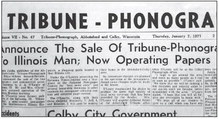Half a century of journalism


The O’Leary family creates newspaper tradition in central Wisconsin
For a half century, the O’Leary family, first under J.A. and his wife Car...


The O’Leary family creates newspaper tradition in central Wisconsin
For a half century, the O’Leary family, first under J.A. and his wife Car...